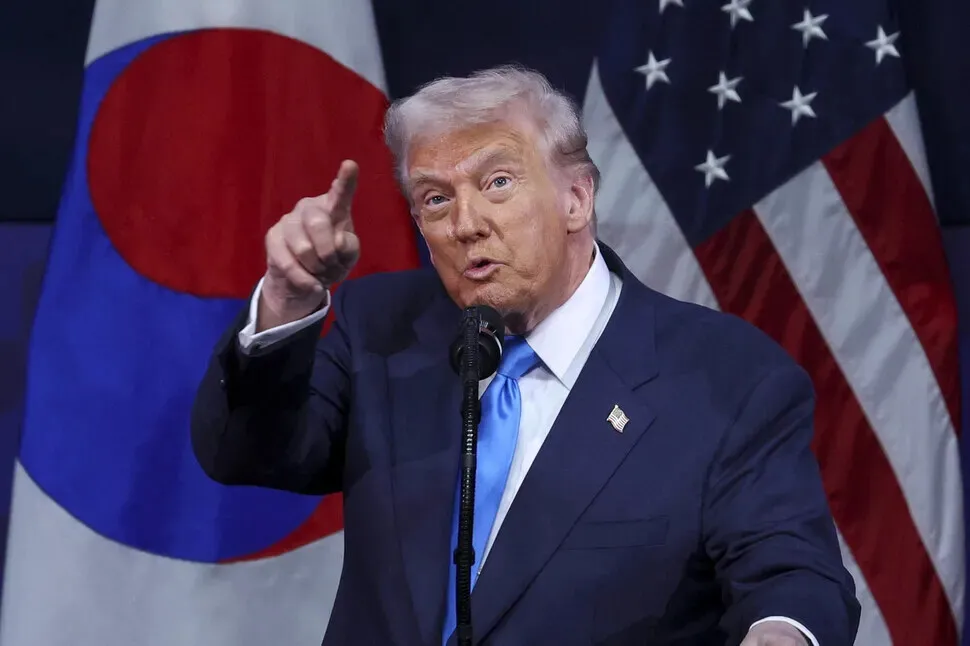US President Donald Trump delivers a keynote on the APEC CEO summit held on the Gyeongju Arts Middle within the metropolis on Oct. 29, 2025. (pool photograph)
South Korea and the US have concluded tariff negotiations, marking a turning level in an intense and carefully watched standoff that began when the 2 events reached a tentative settlement in late July. The deal is the results of a substantial quantity of give-and-take between the 2 sides: limiting the money funding portion of the US$350 billion package deal to US$200 billion, securing reductions on auto tariffs, and acquiring duty-free advantages for prescribed drugs and plane elements. Nevertheless, the burden of fiscal and overseas trade administration implies that the specifics of future money investments and profit-sharing strategies stay fraught.
As a serious US buying and selling associate, South Korea was a key goal, alongside Japan, within the tariff battle initiated by US President Donald Trump upon his return to the White Home in January. The Trump administration threatened to impose a 25% “reciprocal” tariff charge on Korea, citing the nation’s giant commerce surplus with the US as justification.
Whereas claiming to have meticulously calculated applicable charges based mostly on tariffs and non-tariff boundaries, the US’ methodology for calculating the speed of tariffs was, in actuality, outlandish: taking the commerce deficit for the US in items with a selected nation, dividing it by the entire items imports after which dividing the quantity by two.
Regardless of making use of practically zero tariffs on US items underneath their free commerce settlement, South Korea was slapped with eye-watering reciprocal tariffs. Whereas Korea’s presidential transition rendered it troublesome to hurry up negotiations, the US agreed with Japan to decrease its 25% reciprocal tariff charge to fifteen% in trade for a US$550 billion funding within the US. Tariffs on Japanese autos have been additionally decreased from 27.5% to fifteen%.
The similarity in export profiles of Korea and Japan made the previous anxious over the information of Japan’s profitable commerce take care of the US, main the Lee administration to achieve a broad settlement with the US on July 30 to regulate the reciprocal tariff charge and auto tariffs to fifteen% to match that of Japan.
Nevertheless, the 2 events clashed over the specifics of the huge funding. Initially, Kim Yong-beom, the presidential workplace’s coverage chief, defined that the funding package deal wouldn’t be a serious burden for Korea as money investments would account for lower than 5% of the US$350 billion, with the remaining quantity consisting of loans and ensures.
The presidential workplace defined that instantly after the settlement, the US demanded that the funding be made absolutely in money. The Lee administration deemed this unacceptable, contemplating Korea’s overseas foreign money reserves and the dimensions of the financial system, and continued negotiations.
When the US and Japan signed a memorandum of understanding on Sept. 4, formalizing their commerce settlement, the Korean authorities discovered itself on a decent deadline. The speed for reciprocal tariffs was lowered, however the US maintained its 25% on Korean autos till a concrete plan for the funding package deal’s fee was reached.
Seoul and Washington struggled to slim their variations throughout a tug-of-war over the construction of the US$350 billion funding package deal, the targets of funding, the division of income, and different points. Korean Commerce, Power and Business Minister Kim Jung-kwan made a number of visits to Washington to debate the matter with US Secretary of Commerce Howard Lutnick. Kim Yong-beom additionally joined the commerce minister on his go to to the US on Oct. 22 to carry talks with Lutnick. When the chief returned to Seoul on Oct. 24, he said, “The 2 sides stay sharply divided over key sticking factors.”
“The tactic of funding, the quantity of funding, the timeline and the way we’ll share the losses and divide the dividends — all of those stay sticking factors,” Lee mentioned in an interview with Bloomberg Information revealed Monday, emphasizing the worth of “endurance.”
US Treasury Secretary Scott Bessent additionally commented on Monday that he believed that it’s unlikely South Korea and the US would wrap up negotiations this week, stating that he believed that the 2 events have been “not fairly” prepared.
A part of what appears to have pushed Korea to strike a deal is the burden of its vehicles going through a tariff of 25% when getting into the US whereas its major rivals — Japan and the EU — had already negotiated tariffs on their automobiles down to fifteen%. The US, for its half, would have needed to place a bow on negotiations with South Korea through the summit as a message to different nations which might be nonetheless figuring out a deal.
By Lee Bon-young, senior workers author
Please direct questions or feedback to [english@hani.co.kr]

